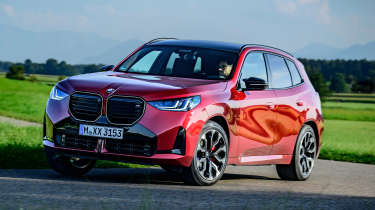BMW X3 - Engines, performance & drive
There’s only one six-cylinder engine in the X3’s range and while it’s great, the four-cylinders provide a decent drive too. Overall dynamics and driving feel remain the best in this sector.

The BMW X3 is a car that belies its growing size, providing a connected and engaging driving experience. BMW has sensibly gone down the route of improving areas of the old X3 by using the same CLAR platform. The all-wheel-drive system that is standard on all models gives it a solid base, but we’d like slightly more feedback from the steering and a little more weight (especially in the hot M50).
There’s no six-cylinder diesel coming to the UK, which is disappointing, but the other powertrains have their own unique qualities, all mixed with the X3’s overriding feeling of secure, stable handling.
| Model | Power | 0-62mph | Top speed |
| BMW X3 xDrive20 | 205bhp | 7.8 seconds | TBC |
| BMW X3 xDrive30e | 294bhp | 6.2 seconds | TBC |
| BMW X3 M50 xDrive | 392bhp | 4.6 seconds | TBC |
What is the BMW X3 like to drive?
In town
The BMW X3 has grown in size over the years and now it’s longer, wider and taller than the first-generation X5. Despite the large proportions, it’s easy to pilot around towns and cities, with a fairly lofty driving position and good all-round visibility.
The turning circle of 12.2 metres is about average for the class, but light steering helps the X3’s low-speed manoeuvrability. Some more family-orientated yet similarly-sized SUVs have tendencies to wallow around, with quick steering ratios and comfort-biased suspension. There’s no hint of this in the X3, though; it feels well tied down.
While the high driving position will always remind you that you’re in an SUV, impressive driving dynamics can sometimes cause you to forget the X3 has traditional SUV suspension travel. As a result, big ruts and speed bumps are dispatched with ease (especially when equipped with smaller wheels).
More reviews
Car group tests
- Land Rover Discovery Sport vs BMW X3 vs Volvo XC60
- BMW X3 vs Mercedes GLC
- BMW X3 M vs Alfa Romeo Stelvio Quadrifoglio
In-depth reviews
Road tests
Used car tests
There’s optional adaptive suspension, too, on all cars except the M50, which gets it as standard. You’ll notice a slight edge to the ride in Sport mode around town, but there’s not a huge amount of difference switching to Comfort. You could happily leave it in Sport all the time.
On A- and B-roads
Along with many of BMW’s range of models, the X3 has developed a reputation for driving engagement and the latest one is certainly one of the better mid-size premium SUVs from behind the wheel. By further developing the CLAR underpinnings used on the old car, BMW has largely improved the X3’s dynamics. There’s a wider rear track, a stiffer body structure and a new five-link rear suspension. The front suspension is a new design too, with “increased precision” when turning into corners, according to BMW.
On the road, the X3 feels pretty similar to the old car – and anyone who’s been in the previous generation model will know that’s no bad thing. The steering is on the light side and while it’s paired with a responsive front end, it’s quite numb. Body roll is kept in check when pushing on, thanks in part to the clever adaptive suspension, a decent amount of grip, but also the lack of weight.
With no all-electric version to cater for (that will arrive on Neue Klasse architecture in 2025), the X3 xDrive20 is relatively light at 1,855kg – compared to 1,895kg for the Audi Q5 TFSI and 1,925kg for the lightest Mercedes GLC. The balance is pretty neutral, but get too eager with your steering inputs and you’ll find some understeer.
The brakes on the standard X3 are perfectly fine for a family SUV, with a firm pedal that doesn’t take too much time to get used to and respectable stopping power. The M50, however, comes with uprated brakes (as you’d hope given the increase in engine output) with big, four-piston calipers over similarly impressive discs. While fitting huge brakes to a fairly sensible family car can often result in some grabby characteristics from the pedal, the power from the M50’s brakes is complemented by confidence-inspiring pedal feel.
On the motorway
The light steering of the X3 does feel secure enough once you’re on the motorway, and overall we’ve found the base xDrive 20 and hot M50 to be comfortable cruisers, despite the variation in wheel sizes.
Like most SUVs, the ride gets a little jittery when going over imperfections at speed, but the damping does a great job of settling things back down quickly. Road noise and wind noise are kept at bay, too.
Engines, 0-60 acceleration and top speed
The range of powertrains in the X3 is both wide and strong. The option of petrol, diesel, plug-in hybrid and what will eventually be the next all-electric iX3 in the Neue Klasse SUV means the X3 has a lot of bases covered.
The mild-hybrid integration is nothing new for the X3 and whether you choose it in the petrol, the diesel or the hot M50, it feels seamless. The 2.0-litre four-cylinder petrol xDrive20 is a smooth engine and with a respectable 205bhp and 330Nm of torque, it’s well-suited to the X3’s size and weight. The xDrive20 manages the 0-62mph sprint in 7.8 seconds.
The diesel might have less power at 197bhp, but with 400Nm it has more torque than the xDrive20 petrol. This additional torque means the xDrive20d’s is a tenth of a second quicker to 62mph than the petrol equivalent. The plug-in hybrid xDrive30e comes with even more power at 294bhp and 450Nm of torque. This is produced by a 2.0-litre four-cylinder petrol unit, and an electric motor which itself makes 184bhp. Despite being the heaviest version of the X3 at 2065kg, the extra power allows the xDrive30e to go from 0-62mph in 6.2 seconds.
BMW’s twin-turbocharged six-cylinder ‘B58’ unit is used in the hot M50. It’s a great engine that feels adept in a wide range of models, including the Z4 M40i. There’s a flexible delivery of power throughout the rev range, thanks to the clever multi-stage variable intake geometry combined with the natural-feeling 48V mild-hybrid system, giving it a responsive, sporty feel.
Our only slight gripe is that it could offer a little more involvement when it comes to noise, but otherwise it’s a fantastic powertrain. With 392bhp and a sizeable 580Nm of torque, the M50 can sprint from 0-62mph in 4.6 seconds before topping out at 155mph. The rest of the line-up is limited to 134mph.
All X3s come with an eight-speed transmission. It’s a delightfully serene gearbox when you’re cruising around, no matter what powertrain it’s mated to. But one feature that is less appealing is the ‘boost’ mode on the downchanging gearshift paddle behind the wheel.
Offered with the M Sport package and on the M50 as standard, it essentially readies the powertrain for sudden bursts of pace, but the reality is that it makes negligible difference and is almost imperceptible. While it’s difficult to see the point in overriding the automatic ’box in the lesser-powered models, in the M50 we’d recommend switching the gear selector to ‘Sport’ and ‘Manual’, which results in faster gear changes than if you simply flicked the paddle whilst in automatic mode. A welcome touch is the satisfying thump to the drivetrain during upshifts upon heavy acceleration in the M50.












